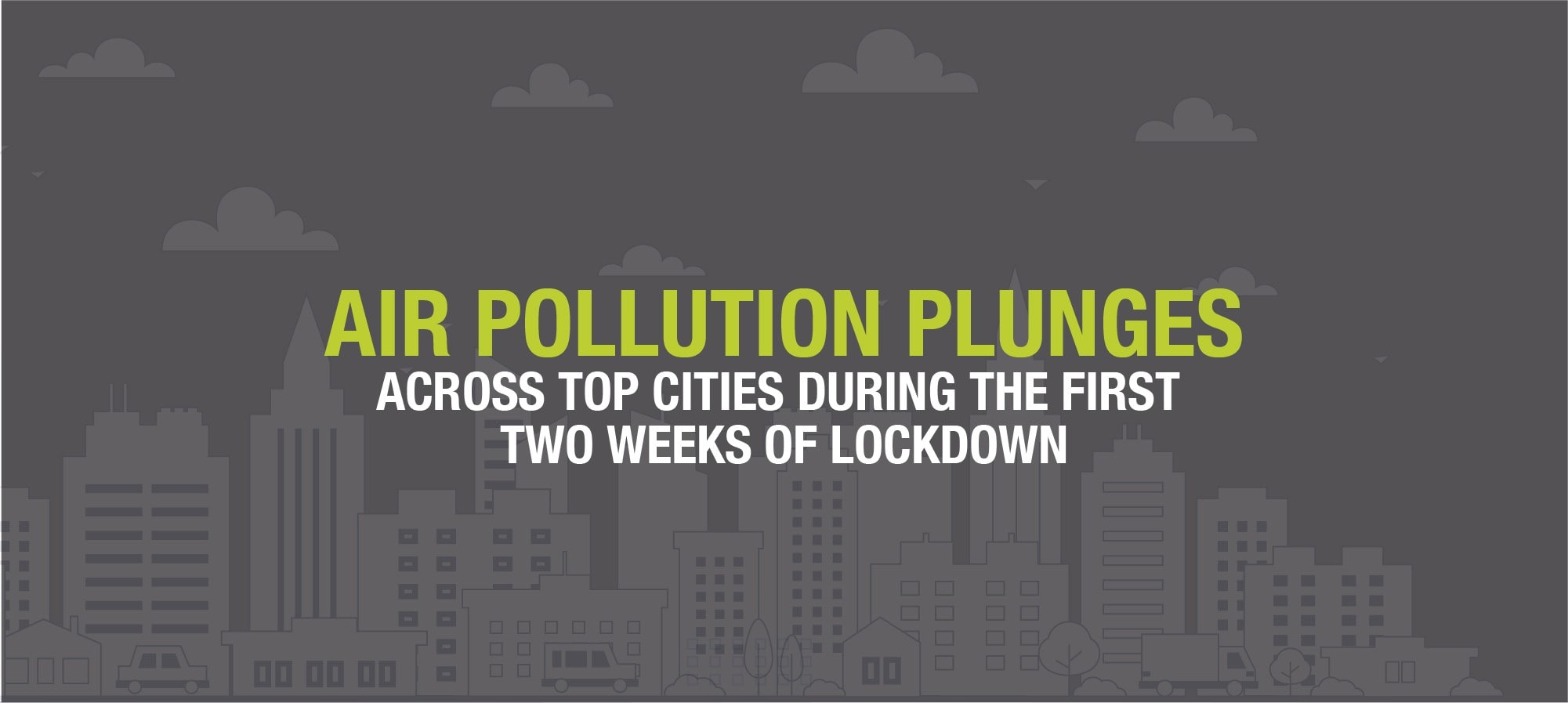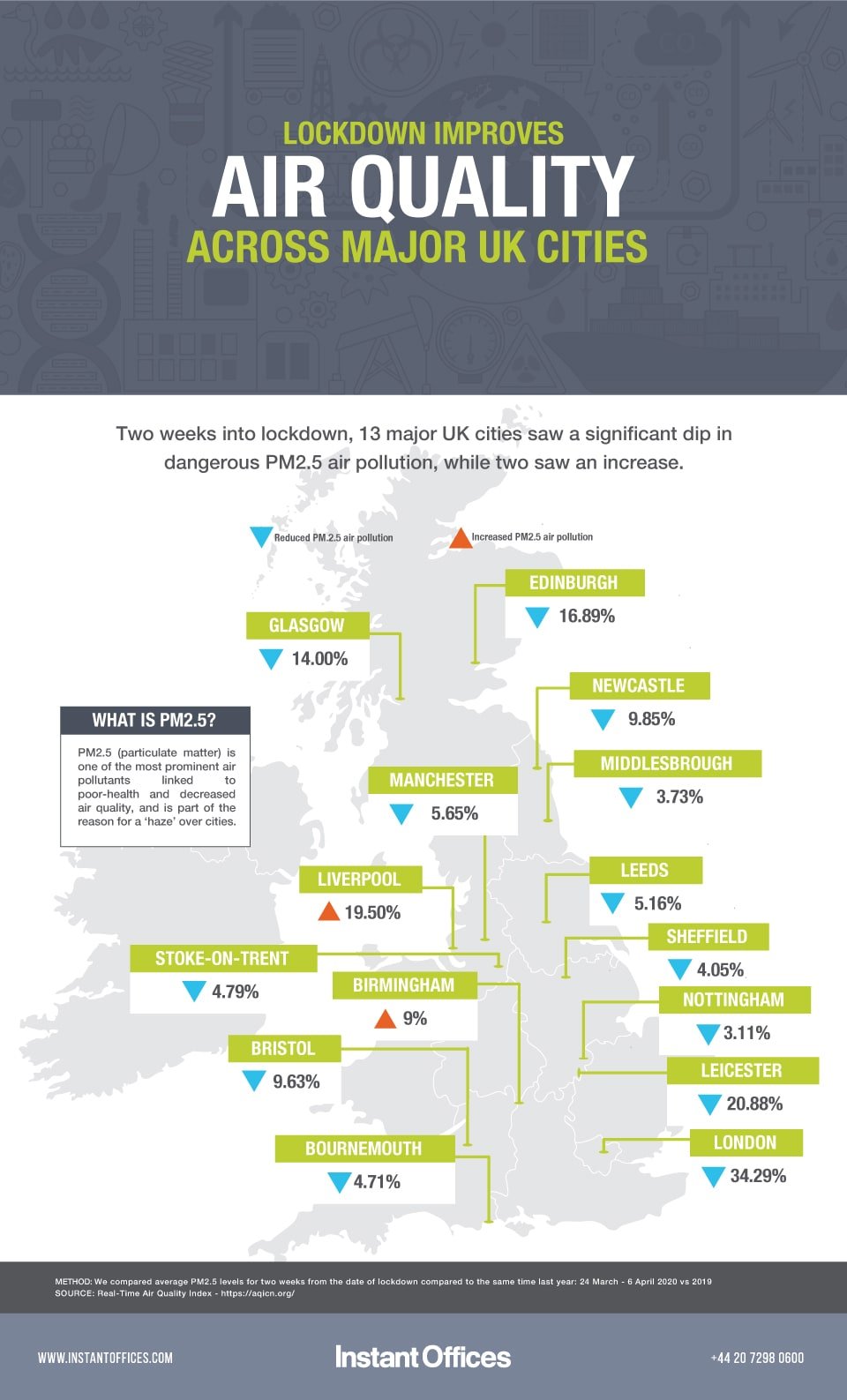The link between COVID-19 and air quality was first seen from space when satellite data showed reduced pollution over Italy as a result of lockdown measures. Soon after, we observed reduced boat traffic in Venice as the canals ran clearer.
Source
Similar stories started popping up all over the world as other countries went into lockdown:
- In north Wales, wild Kashmiri goats started exploring empty city streets.
- In India, the Himalayas became visible for the first time in 30 years.
- In San Francisco, wild coyotes were spotted on the Golden Gate Bridge.
- China, the world’s largest emitter of carbon dioxide, had a 25% drop in emissions correlating to the nationwide quarantine.
Coinciding with this unprecedented global pause in daily activities, particulate matter, or PM2.5, one of the most hazardous and prominent types of air pollution, saw a considerable decline.
Air Pollution Improves Two Weeks into Lockdown
PM2.5 concentration in the air is measured in micrograms per cubic meter. Levels of PM2.5 in the air are measured by assigning a number based on a scale from 0 (good) to 500 (bad). Using real-time data from the World Air Quality Index, we compared average PM2.5 numbers for two weeks from when lockdown began in each city, compared to the same time last year.
These major cities saw substantial improvements in air quality just two weeks into lockdown due to a decrease in PM2.5
| City | PM2.5 Average Score 2019 | PM2.5 Average Score 2020 | Decrease |
|---|---|---|---|
| Delhi | 169 | 111 | 34.29% |
| Los Angeles | 42 | 30 | 28.38% |
| Madrid | 64 | 48 | 25.83% |
| New York | 33 | 25 | 25.76% |
| London | 60 | 49 | 18.07% |
| Wuhan | 177 | 151 | 14.65% |
| Paris | 77 | 69 | 10.98% |
| Berlin | 27 | 25 | 6.42% |
| Rome | 41 | 39 | 5.88% |
Of the analysis, Edward Harbison, Corporate Marketing Manager for the Instant Group, says “The significant reduction of PM2.5 across major cities in only two weeks of lockdown, is evidence of the staggering impact we have on the world around us. With reduced human activity across the board, our analysis showed a significant improvement in some of the worlds most polluted cities. Considering the impact that PM2.5 has on air quality and our overall health, this is especially noteworthy.
While a global health crisis is not the solution to climate change, it is a good time for all of us to reflect on our environmental impact, how truly connected we are, and ways we can move forward with more sustainable practices, especially in business. While these dips may be temporary, we’re hoping some of the positive stories, satellite imagery, photographs, and widely covered analysis can inspire us to become part of the global effort to address climate change for the long term.”
Top three cities with the most significant drops:
Delhi lockdown began on the 24th of March. Just seven days after lockdown started the average PM2.5 score dropped by 60.33%, plunging from 184 last year to 73.
Source
Los Angeles lockdown began on the 21st of March. Just six days later, the average PM2.5 score dropped by almost 71% compared to last year, from 55 to only 16.
Source
Madrid lockdown started on the 14th of March. Four days later, the average PM2.5 dropped over 56%, from 89 to 39.
Source
Beijing sees a rise in PM2.5 during lockdown
Interestingly, although nitrogen dioxide pollution fell in Beijing during lockdown, PM2.5 increased by 41.79% in two weeks when lockdown began on 9 February when compared with the same period in 2019. This is likely due to many of China’s state-owned factories remaining open during lockdown.
In addition to reduced PM2.5 and other pollutants, COVID-19 is also set to cause the most substantial dip in CO2 emissions the world has ever seen.
Lockdown Has Impacted Air Quality in 13 of the UK’s Largest Cities
PM2.5 levels differ significantly around the UK, with poor-health related to PM2.5 being responsible for more than 1 in 19 deaths across the country, typically concentrated in cities. The World Health Organisation also predicts that long-term exposure to PM2.5 could decrease life expectancy by an average of one year across Europe.
To find out how lockdown impacted PM2.5 levels across major cities in the UK, we compared average scores for two weeks starting from the 23rd March, the day the UK went into lockdown, to the exact timeframe in 2019. Data showed a major dip in 13 of the largest cities, with London, Leicester, Edinburgh, Glasgow and Swansea’s average scores all plunging by double digits.
London drops by 34.29%
A 34.29% drop in average PM.25 levels in London just two weeks into lockdown is notable, as the capital is known for having the highest number of PM2.5-related deaths in the UK, with 1 in 16 people estimated to die from exposure annually.
Along with this drop, Mayor of London Sadiq Khan has said London’s air quality has dramatically improved due to an almost 50% reduction in nitrogen dioxide, NO2, another dangerous type of air pollutant closely linked to transport.
Leicester drops by 20.88%
With average PM2.5 levels decreasing by 20.88%, the city with the second most significant improvement to air quality two weeks into lockdown is Leicester. As human activity slowed across the city, March 24 – 6 April saw PM2.5 scores decrease by 20.88% compared to the same time last year.
In 2018, Leicester ranked 11th on a list of the most polluted cities in the UK, with studies revealing that PM2.5 exceeded recommended global air pollution limits by two points. Last year, the city became one of the first in the UK to monitor and map PM2.5 under a government-funded project to study air pollution, with a plan to mount sensors across to city to gather data that will be published late in 2020.
Air Quality Improves Across Most UK Cities
Manchester and Newcastle, some of the largest UK cities by population after London, all saw a dip in PM2.5, while Birmingham and Liverpool both saw an increase, at 9% and 19.5% respectively.
In Scotland, both Glasgow and Edinburgh saw improved air quality with drops of 14% and 16.89%. Similar to London, Edinburgh has also seen a 50% drop in NO2, which has improved air quality significantly during the crisis.
According to the Centre for Cities, major contributors to air pollution across UK cities are transport and burning fuels, while half of PM2.5 toxins come from coal fires and wood-burning stoves.
Air Pollution Makes Us More Vulnerable to COVID-19 Symptoms
According to the World Health Organisation, Particulate matter, or PM2.5 is one of the most prominent air pollutants linked to poor-health. It not only impacts air quality and contributes to the foggy haze we often see in cities and industrial areas but inhaling these ultrafine particles with every breath can add to a range of health problems in the short and long-term, including respiratory issues.
Air pollution contributed to 1 in 10 deaths worldwide in 2017 – almost 5 million people. PM2.5 specifically contributed to 3 million early deaths, with the majority occurring in China and India.
Some natural sources of PM2.5 include pollens, dust storms and fires, and prominent human-made sources include vehicles, fossil fuel power plants and most industrial processes.
A recent study from Harvard recently linked long-term exposure to air pollution with increased COVID-19 death rates, stating that if Manhattan had a lower PM2.5 level by just one point, it could have reduced COVID-19 deaths by 248 in the month of March.
How Businesses Can Become More Sustainable Post-COVID-19
The short-term impact of the COVID-19 crisis is enormous, and governments are being urged to learn from the crisis and adapt policies, but how can businesses contribute to a more sustainable future going forward?
- Measure your carbon footprint: The first step to reducing the carbon footprint of your business is to measure your current output. Setting a benchmark is the first step in planning a reduction strategy. A third-party audit enables companies to calculate and map emissions throughout the organisation, from office space and operations to travel and logistics. This plan will help you identify the strategy needed to reach net-zero. Some of the largest companies in the world have already committed to net-zero emission strategies, including Nestle and Qantas.
- Set reduction targets: Each industry faces a unique set of challenges and opportunities when it comes to business and climate change, but the one way you can measure success as you move towards becoming more sustainable is by setting reduction targets. This could be around the energy efficiency of your office space or commercial space, staff training, and using sustainable energy and electricity. It is crucial to sense-check that your targets are realistic and fit in with overall business goals.
- Support climate policies: Enable your organisation to support climate action that is working towards a more sustainable future. Discover what action your city is taking to help reduce climate change and get involved. C40 Cities has a useful tool that enables you to filter cities according to initiative. Some of the greenest cities in the world have some strong actions in place. In the UK, greener designs could save the economy an estimated £15.3bn by 2025.
Other ways to reduce your business impact:
Continue with remote working: Companies have already invested in remote working during the crisis, and the trend is set to continue. As well as reducing business overheads, remote working reduces fuel usage, office waste, energy use and greenhouse gas emissions. Globally, working from home half the week could reduce emissions by 54 million tons a year.
Reduce commuting for staff: Road traffic is responsible for up to 50% of particulate matter around the world. In addition to reducing time spent wasted commuting in some of the most congested cities in the world, and thereby increasing staff happiness, a reduced commute could also positively impact the environment by reducing transport-generated air pollution. This could be done by increasing remote working options for staff, or by encouraging the utilisation of coworking space, serviced offices or flexible commercial property close to home.
Find a flexible office near you
Looking for Office Space?
We Operate in Some of the World’s Top Cities:
London, New York, San Francisco, Paris, Singapore, Hong Kong,
Search more locations





